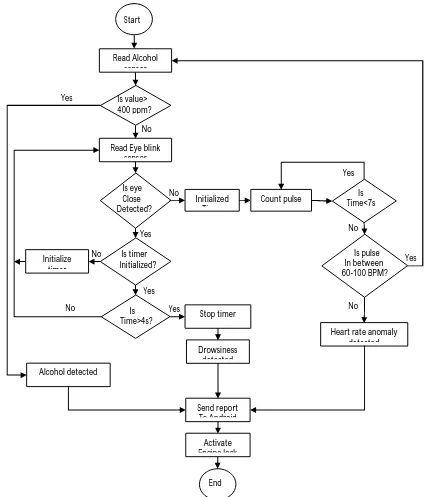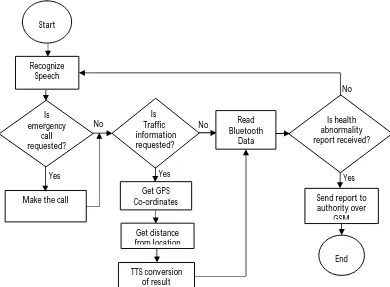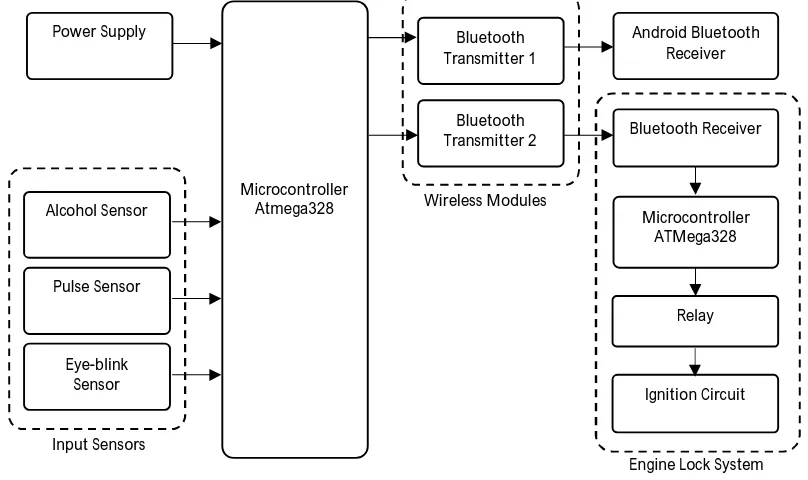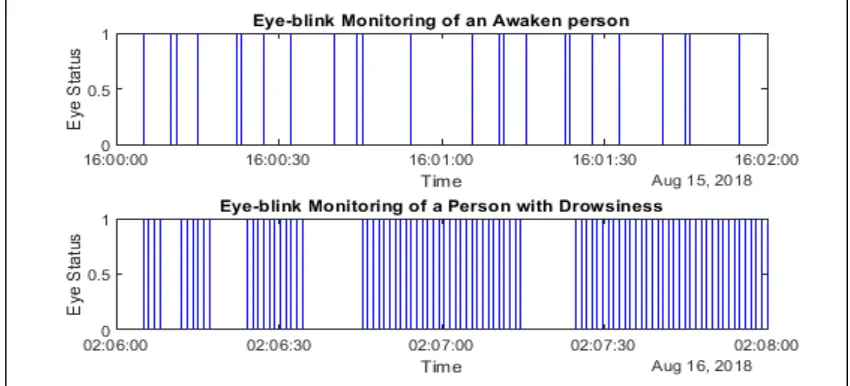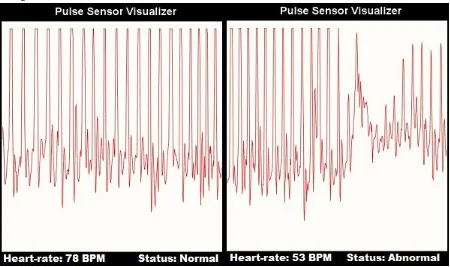424
©IJRASET: All Rights are Reserved
Wearable Wireless Headset based Driver
Assistance System to Ensure Vehicle Safety
Md. Ferdous Wahid1, Tasnim Ahmed2, Md. Abu Nasim3, Md. Shahin Alom4 1, 2, 3, 4
Department of EEE, Hajee Mohammad Danesh Science and Technology University, Dinajpur, Bangladesh
Abstract: Driver assistance systems are generally designed to ensure driver’s comfort and vehicle safety. These systems perform multiple tasks to assist the drivers allowing them to focus on driving. It can also be designed to monitor the health condition of the drivers. But such a complicated system requires multiple sensors and modules that makes it expensive and unaffordable to many vehicle drivers. Moreover, such systems are not portable and attached permanently to the vehicles in most cases. Thus an inexpensive vehicle-independent driver assistance system becomes required to ensure mass usage and vehicle safety. In this paper, we have investigated an approach to develop a portable driver assistance system using wearable sensors and hands-free communication technologies. The proposed system is implemented on a wearable headset that contains the sensors and can be connected to the android phone of the driver wirelessly. The sensors of the headset are used to monitor the breath-alcohol level and drowsiness of the driver along with his heart-beat status. If the driver is found with physical disorder due to alcohol-impairment or irregular heart-beat, it can automatically lock the vehicle engine and acknowledge the traffic-safety authority about the driver’s position and physical condition using the android phone. The headset also contains a bluetooth earphone with speaker that allows drivers using voice commands to make or receive emergency phone-call without physically interacting with the phone. The system can also provide auditory notification to the driver about the location and speed of the vehicle.
Keywords: Driver Assistance System, Wearable headset, Hands-free technology, Health monitoring, Vehicle safety.
I. INTRODUCTION
Physical disorder due to consumption of alcohol or drowsiness has become one of the major reasons of traffic accident fatalities in recent years. Alcohol causes temporary impairment of vision and hearing that results in the inability of sensing balance and coordination. As a consequence, the driver feels drowsy and loses control over the vehicle that leads to the occurrence of an accident. It has been found that alcohol consumption exponentially increases the risks of accidents [1]. Driving in drunken condition is considered to be responsible for the death of around ten thousand individuals per year in Europe [2]. On the other hand, multi-tasking such as using cell-phones while driving is another major reason for the driver’s being distracted and causing deadly incidents. It is estimated that, the usage of mobile phones during driving is responsible for 25% of all road-crashes in the USA [3]. But the occurrence of this phenomenon has increased by 1 to 11% in many countries in the past 5-10 years [4]. Therefore, implementation of advanced technologies has become necessary for the prevention of driving with physical disorder and safely using communication devices in vehicles to reduce traffic fatalities.
Many technologies have been introduced in the recent years to prevent the drivers with abnormal physical conditions from controlling the vehicles. Near-infrared (NIR) Spectroscopy [5] or Wavelength-modulated Photo-thermal radiometry [6] are used for non-invasive blood-alcohol detection of vehicle drivers. Breath-alcohol detection systems are also implemented using breathalyzer with alcohol dehydrogenase (ADH) sensors [7]. Again, the drowsiness of the driver can also be detected based on eye-blink or head-movement monitoring using Infrared (IR) sensors [8] or Computer Vision Technologies [9]. Pulse sensors can also be used to detect abnormal heart-rate of the driver or predict the possibility of sudden cardiac-arrest [10]. On the other hand, many hands-free technologies have been introduced to prevent the vehicle drivers from physically interaction with their cell-phones while driving. Such technologies involve driver’s speech recognition [11] or Hand-gesture recognition [12], Auto-Reply SMS systems, GSM and GPS Based Accident Alert [13] and so on.
425
©IJRASET: All Rights are Reserved
automobiles. Thus we were encouraged to design an inexpensive and portable vehicle assistance system combining modern technologies to ensure comfort and safety of the vehicle drivers.
In this paper, we have designed an assistance system for vehicle drivers by combining the vehicle safety systems with hands-free wireless communication technologies in a wearable headset which is connected wirelessly with an android phone. The headset contains an alcohol sensor, an eye-blink detector and a pulse sensor to monitor breath alcohol level and drowsiness of the driver along with his heart-beat status. If any physical disorder is detected, the system can automatically lock the vehicle engine and acknowledge the traffic-safety authority about the driver’s current condition using android SmsManager API. Again, auditory notification about the location and speed of the vehicle is provided to the driver wirelessly via a bluetooth-earphone of the headset using android Location and Speech API. The system also recognizes voice commands using CMU Sphinx API and allows drivers making or receiving an emergency phone-call using android Telephony API. Thus the driver can use the android phone without performing any physical interaction with it. The system is designed maintaining the hands-free law, which has been enforced recently in Georgia, Atlanta, USA [20].
II. SYSTEMCONFIGURATION
[image:2.612.84.513.300.454.2]The proposed driver assistance system is designed based on a hands-free wearable headset device that contains sensors for continuously monitoring driver’s physical condition. It also has Bluetooth modules to wirelessly communicate with the android phone and the engine locking system. The structural configuration of the proposed model is presented in Fig. 1.
Fig. 1 Structural Configuration and implementation of the proposed Driver Assistance System
The headset contains a wireless Bluetooth earphone, which is set to driver’s ear. It also contains a microcontroller and Bluetooth module, mounted on the earphone. The driver is also provided with a safety goggle that contains the eye-blink detector. Then, the pulse-sensor is attached to the earlobe and the Breathalyzer is placed close to the mouth. All sensors are connected to the microcontroller where sensor data are checked for physical disorder. The flowchart of Fig. 2 represents operational overview of the headset device.
Fig. 2 Operational overview of the headset device
The microcontroller continuously monitors driver’s health condition using sensors. If any physical disorder is detected, the information is sent to android and the engine locking System gets activated. The android phone application finally acknowledges the traffic safety authority about the driver by sending text messages to them. The application can also recognize driver’s speech and respond to him by providing auditory output to the earphone.
Eye-blink Sensor
Alcohol Sensor Pulse Sensor
Bluetooth Module Earphone
Microcontroller Goggles
Start Read sensors
Send report to Android
Activate engine lock Is abnormality
detected?
Yes No
[image:2.612.46.559.544.640.2]426
©IJRASET: All Rights are Reserved
III.METHODOLOGY
The wearable headset has to communicate wirelessly with driver’s android phone and vehicle’s engine lock system to facilitate hands-free communication environment and handle emergency situations. In this section, we will discuss briefly about the operations of each of these devices.
A. The Wearable Headset
[image:3.612.78.506.223.720.2]The wearable headset contains sensors. A breath-alcohol detector or breathalyzer detects driver’s breathe alcohol level, eye-blink monitor detects drowsiness and pulse sensor monitors driver’s heart-beat status to predict the possibilities of sudden cardiac arrest. Bluetooth modules are used to facilitate wireless communication with android and Engine lock system. Here the microcontroller is used to collect and analyse sensor-data and conduct the decision making process. The complete operation is represented as a flowchart in Fig. 3
Fig. 3 Flowchart of the wearable headset system’s complete operation Start
Read Alcohol sensor
Is value> 400 ppm?
Read Eye blink sensor
No
Is eye Close Detected?
Is timer Initialized?
Yes
Is Time>4s?
Initialized Timer No
Count pulse Is
Time<7s
Is pulse In between 60-100 BPM?
No
Heart rate anomaly detected No
Yes
Stop timer
Drowsiness detected
Send report To Android
Activate Engine lock Alcohol detected
Initialize timer
Yes
Yes No
Yes
Yes No
427
©IJRASET: All Rights are Reserved
The flowchart of Fig. 3 showed us the decision making process of the microcontroller using sensor readings. The load-resistance of MQ-3 alcohol detector was set to 200 ohm, so that the sensitivity can be adjusted to 0.4mg/L or 200 parts-per-million (PPM) as default alcohol-concentration level in open air [21]. Therefore, the value of breath alcohol level is considered to be normal when it is in between 0 to 200 PPM. But the driver is considered to be in drunken condition if the level exceeds 300 PPM. The process of drunken condition detection was conducted maintaining the ppm value range as represented in TABLE I.
TABLEI
DECISION STATUS OF MICROCONTROLLER FOR DIFFERENT RANGES OF PPMVALUES
Alcohol-sensor Reading
0 – 200 ppm 201-300 ppm 301 – 400 ppm 401 – above
Decision Status Normal Air Alcohol Level Medium Alcohol Existence Level
Drunken or High Alcohol Existence
Level
Blind Drunk or Severe Alcohol Existence
Level
The eye-blink sensor on the other hand, uses an IR transmitter-receiver pair to monitor drowsiness of the driver. The output of IR receiver becomes low or high depending on the eye-status to be opened or closed respectively. The system considers drowsiness when the IR receiver output is found to be low for more than 3 seconds. At last, we count driver’s pulse for seven seconds and determine the beats-per-minute (BPM) value. The pulse-rate is considered normal when the BPM value is in between 60 to 100 [16]. But when the value is below 60 or above 100, the driver is considered to be in the state of Bradycardia or Tachycardia respectively. Such phenomena represent abnormality in heart-rate. Finally, the microcontroller sends the health-status of the driver to the android phone via Bluetooth when abnormal readings are found from any of the sensors. It also remotely locks the vehicle engine by sending commands to the engine locking system.
B. The Android Application
[image:4.612.123.513.435.722.2]The android application plays an important role in the vehicle assistance system by continuously recognizing speech and proving hands-free wireless navigation and communication support to the driver. The complete operation is shown in Fig. 4.
Fig. 4 Flowchart of the Android application’s complete operation Start
Recognize Speech
Make the call
Yes No Get GPS Co-ordinates Yes Get distance from location No No
428
©IJRASET: All Rights are Reserved
In order to recognize driver’s voice commands, the android application uses CMU Sphinx API which is programmed for keyword recognition in continuous speech. The system is designed to recognize two specific commands: “Give location status” and “Call emergency number”. As a response to the first command, the application activates GPS and figures out the current location and speed of the vehicle, along with the distance from pre-located destination. The results are then represented to the driver as auditory output using Android Speech API and it can be heard using the Bluetooth earphone. Similarly, the second command instructs the application to make a phone call to a pre-entered emergency number using Android Telephony API. The application also receives reports of physical disorder from the headset via Bluetooth and sends the information to the traffic control authority using SMS Manager API.
C. The Engine locking system
[image:5.612.91.511.253.376.2]The Engine locking system is designed to wirelessly operate the ignition system of the vehicle to be on or off. This system is essential to stop the vehicle during emergency conditions such as driver’s physical disorder. The complete operation of the system is represented in Fig. 5
Fig. 5 Flowchart of the Engine locking system’s complete operation
The microcontroller of the system receives command from the headset unit via Bluetooth and switches a relay module on or off according to the command. The relay controls the current flow through the ignition circuit and thus makes the engine to be on or off.
D. Experimental Set-Up
In this section, we have represented the complete system-model including all mechanisms and sub-systems of the proposed driver assistance system. The experimental setup is shown as a block-diagram in Fig. 6.
Fig. 6 Block diagram of the complete Driver assistance system
Start Receive command
Via Bluetooth
Relay logic Low
Keep relay Logic High
Ignition Switch OFF
Ignition Switch ON Is
Commanded to unlock engine?
Yes
No
Power Supply Android Bluetooth
Receiver
Microcontroller
Atmega328 Wireless Modules
Input Sensors
Bluetooth Transmitter 2
Bluetooth Transmitter 1
Engine Lock System Microcontroller
ATMega328 Bluetooth Receiver
Relay
Ignition Circuit Pulse Sensor
[image:5.612.95.499.475.715.2]429
©IJRASET: All Rights are Reserved
The proposed driver assistance system uses two ATMega328 microcontroller based embedded systems. One for the driver’s physical condition monitoring using input sensors and another for wirelessly controlling the engine locking system. The eye-blink sensor is connected to a digital input pin of the microcontroller while the pulse and alcohol sensors are connected to two 10 bit ADCs of the microcontroller to provide analogue readings. The relay module of the engine locking system is connected to a digital output pin of the system’s microcontroller. It is switched in between on or off states to control the current flow through ignition circuit.
IV.RESULTANDDISCUSSION
The system was practically implemented on an automobile while the driver was equipped with the wearable headset to evaluate the performance of the system. We connected both of the microcontrollers to a computer using serial ports to store sensor data for a particular period of time. We also monitored the decision making process of the microcontrollers to evaluate the efficiency of the system for handling emergency situations by creating multiple test scenario.
[image:6.612.170.445.275.441.2]We equipped two individuals with our wearable headset and one of them consumed alcoholic beverage 15 minutes before the test was conducted. We stored the alcohol sensor data for both of the normal and alcohol-impaired individuals and plotted them altogether as shown in Fig. 7
Fig. 7 Graphical Representation of alcohol sensor readings for normal and alcohol-impaired person
From Fig.7 it is observed that, the alcohol-sensor output for the alcohol-impaired person is far greater than the normal person which went beyond 400 PPM within 5 minutes. So the alcohol sensor works properly and capable to identifying the affected person. We also monitored the drowsiness status of a person in different situations using the eye-blink sensor. The eye-blink sensor reading for both normal and drowsy condition are represented graphically in Fig. 8.
[image:6.612.98.523.519.712.2]430
©IJRASET: All Rights are Reserved
The eye-blink monitoring process was first conducted on a person who was completely awaken and rested well. The sensor detected eye-blinks but they occurred occasionally. The average duration of each blink was less than a second and therefore, the eye-status was never found to be closed for more than a second. But when the sensor was applied to a person who was naturally falling asleep, the eye-blink rate was greater than usual and therefore, the duration of being the eye to be closed started to increase. Then we collected the analogue reading of the pulse sensor for a normal person and an Asphyxia patient and plotted the sensor data for both of them to recognize the difference. The difficulty to breathe of the Asphyxia patient was properly analysed by the system and treated as abnormal.
[image:7.612.87.537.193.461.2]The numerical and graphical representation of pulse-sensor reading for both of a normal person and an Asphyxia patient are represented in Fig. 9.
Fig. 9 Pulse-sensor reading of a normal person and an Asphyxia patient
Due to the difficulty of breathing, the pulse rate of the Asphyxia patient was irregular which was properly monitored by the system. Thus the wearable headset performed all of its operations properly and ensured continuous health diagnosis for vehicle drivers.
V. CONCLUSIONS
Driver assistance systems are essential to ensure driver’s comfort and vehicle’s safety. But such systems are generally expensive and implemented to the vehicles permanently. Thus mass usage of these technologies are not being possible. Therefore, we designed a portable and vehicle-independent driver-assistance system that continuously monitors driver’s physical condition and also allows him to use multiple hands-free technologies. The system was implemented in a wearable headset that can wirelessly control the vehicle’s ignition system and communicate with driver’s android phone via Bluetooth. The headset also contains sensors to continuously monitor driver’s breath-alcohol, drowsiness and heart-pulse. Thus the system prevents drivers from driving with physical disorder by automatically locking the vehicle’s ignition system. Moreover, the developed android application can recognize driver’s speech and provide notification on vehicle’s location and speed as auditory output to headset. It can also receive reports on driver’s physical disorder from headset and acknowledge the traffic-safety authority by sending them text-messages if necessary. Thus the system becomes inexpensive, hands-free, user-friendly and efficient enough to perform its operations.
REFERENCES
[1] M. D. Keall, W. J. Frith, and T. L. Patterson, “The influence of alcohol, age and number of passengers on the night-time risk of driver fatal injury in New Zealand,” Accident Analysis and Prevention, vol. 36, no. 1, pp. 49–61, 2004.
[2] European Commission, “Saving 20000 lives on our roads,” Tech. Rep. COM 2003/311, European Road Safety Action Programme, 2003
431
©IJRASET: All Rights are Reserved
[5] W. Liu, G. Liu, X. Wang, Yan-fei Bao, Gang Li, Hui-quan Wang, “Non-invasive measurement study of human blood alcohol concentration based on NIR dynamic spectrum,” In proceedings of International Conference on Image Analysis and Signal Processing, Oct. 2011.
[6] X. Guo, A. Mandelis, Y. Liu, B. Chen, Q. Zhou, Felix Comeau, “Noninvasive in-vehicle alcohol detection with wavelength-modulated differential photo thermal radiometry, ” PubMed Central Journal on Biomedical Optics Express, Volume 5, Issue 7, pp. 2333-2340, Jul 2014.
[7] E. Bihar, Y. Deng, T. Miyake, M. Saadaoui, G. G. Malliaras, M. Rolandib, “A Disposable paper breathalyzer with an alcohol sensing organic electrochemical transistor,” PubMed Central Scientific reports, Jun 2016.
[8] D. Lee, S. Oh, S. Heo, M. Hahn, “Drowsy Driving Detection Based on the Driver's Head Movement using Infrared Sensors,” In proceedings of Second International Symposium on Universal Communication, pp. 231-236, Dec. 2008.
[9] M. Chakraborty, A. N. H. Aoyon, “Implementation of Computer Vision to detect driver fatigue or drowsiness to reduce the chances of vehicle accident,” In proceedings of International Conference on Electrical Engineering and Information & Communication Technology, April 2014.
[10] Joseph P. Ornato, Mary M. Hand, “Warning Signs of a Heart Attack,” Circulation: Journal of American Heart Association, 2001, pp.1212-1213.
[11] Y. Zheng, Xian Shi, A. Sathyanarayana, N. Shokouhi, J. H. L. Hansen, “In-vehicle speech recognition and tutorial keywords spotting for novice drivers performance evaluation,” IEEE Intelligent Vehicles Symposium (IV), pp. 168-173,July 2015.
[12] P. Molchanov, S. Gupta, k. Kim, K. Pulli, “Multi-sensor system for driver's hand-gesture recognition,” In proceedings of 11th IEEE International conference and Workshops on Automatic Face and Gesture Recognition (FG), May 2015.
[13] Janani. N, Saranya. N, “Driver safety awareness and assistance system for cognitive vehicle control,” In proceedings of IEEE International conference on Advanced Communications, Control and Computing Technologies, pp. 968-973, May 2014.
[14] K. Sakakibara, T. Taguchi, A. Nakashima, T. Wakita, S. Yabu, B. Atsumi,“ Development of a new breath alcohol detector without mouthpiece to prevent alcohol-impaired driving,” In proceedings of IEEE International Conference on Vehicular Electronics and Safety, 2008.
[15] N. Janani, N. Saranya, “Driver Safety Awareness and Assistance System for cognitive Vehicle Control,” In proceedings of IEEE International Conference on Advanced Communication Control and Computing Technologies, 2014, pp. 968-973.
[16] E. Abe, K. Fujiwara, T. Hiraoka, T. Yamakaway, M. Kano, “Development of Drowsy Driving Accident Prediction by Heart Rate Variability Analysis,” In proceedings of Annual Summit and Conferences of Asia-Pacific Signal and Information Processing Association,2014.
[17] M. Raja Raghavan, N. S. Bhuvaneswari, “Intelligent safety and security systems in automobiles,” In proceedings of IEEE Technological Innovation in ICT for Agriculture and Rural Development (TIAR), 2015, pp. 188-192, 2015.
[18] C.V Anilkumar, M. Ahmed, R. Sahana, R. Thejashwini, P.S Anisha, “Design of Drowsiness, Heart Beat Detection System and Alertness Indicator for Driver Safety,” In proceedings of IEEE International Conference On Recent Trends in Electronics Information Communication Technology, 2016, pp. 937-941. [19] L. Lu, S. Li and Y. Li, “Design of car Bluetooth hands-free mobile phone system in Linux system,” In proceedings of International Conference on Automatic
Control and Artificial Intelligence , 2012, pp. 836-839.
[20] (2018) Georgia's Hands-Free Law [Online]. Available: https://www.gahighwaysafety.org/highway-safety/hands-free-law/ [21] “MQ-3 Gas Sensor data sheet,” Hanwei Electronics Co., Ltd, Henan, China.

